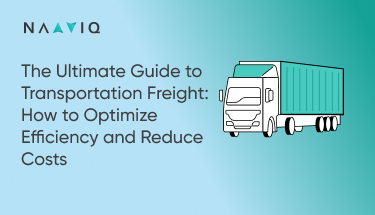Understanding Load Planning
Load planning is the process of determining how goods should be loaded onto a vehicle to maximize efficiency while ensuring safety and compliance. This involves considering factors such as weight distribution, cargo type, delivery schedules, and vehicle capacity. A well-executed load plan results in lower transportation costs, better resource utilization, and improved customer satisfaction.
Traditional load planning methods often rely on manual processes, spreadsheets, and human judgment, which can lead to inefficiencies, errors, and increased operational costs. However, with the advancement of logistics technology, businesses now have access to Transport Management Systems (TMS) like NaaviQ, which automate and optimize load planning for better efficiency.
Key Strategies for Efficient Load Planning
1. Leverage Advanced Technology
Manual load planning is prone to errors, inefficiencies, and delays. A robust TMS like NaaviQ automates load planning by analyzing factors such as shipment size, vehicle capacity, delivery routes, and real-time constraints to create optimized plans. AI-driven algorithms ensure better utilization of assets, reducing wastage and improving profitability.
NaaviQ TMS employs machine learning models that analyze historical data, industry trends, and real-time inputs to suggest optimal loading patterns. This not only reduces operational time but also ensures maximum capacity utilization.
2. Implement Load Consolidation
Combining multiple shipments into a single load maximizes vehicle capacity and reduces transportation costs. Load clubbing, a feature in NaaviQ TMS, allows businesses to group compatible shipments, reducing empty space and enhancing efficiency. Consolidation also helps in meeting sustainability goals by lowering carbon emissions.
Load consolidation also contributes to improved supply chain resilience, as businesses can reduce dependency on multiple carriers and avoid unnecessary delays. Cross-docking techniques can further streamline load planning by reducing storage time and expediting shipments.
3. Optimize Route Planning
Route optimization is a critical aspect of load planning. By integrating real-time traffic data, road conditions, and weather forecasts, NaaviQ’s intelligent routing feature ensures the most efficient delivery routes. This minimizes fuel consumption, transit times, and overall logistics expenses.
Effective route planning also considers factors such as time windows for delivery, driver availability, and regulatory restrictions to create feasible and cost-effective routes. Dynamic routing helps businesses respond to unexpected disruptions, such as road closures or traffic congestion, without affecting delivery schedules.
4. Balance Load Distribution
Uneven weight distribution can lead to vehicle instability, safety risks, and increased fuel consumption. Efficient load planning ensures that weight is evenly distributed within legal limits, reducing wear and tear on vehicles and preventing compliance violations.
NaaviQ TMS includes automated weight distribution calculations that help in balancing loads effectively. This not only enhances vehicle longevity but also improves fuel efficiency and overall fleet performance.
5. Utilize Predictive Analytics
Historical data and predictive analytics help anticipate demand fluctuations, ensuring optimal load planning. NaaviQ TMS uses AI to analyze past trends and suggest load distribution strategies, preventing capacity underutilization and overloading scenarios.
Predictive analytics can also help identify seasonal demand patterns, allowing businesses to plan for peak periods effectively. By forecasting demand, companies can allocate resources more efficiently and avoid last-minute capacity shortages.
6. Enable Real-time Visibility & Tracking
Real-time tracking allows businesses to monitor shipments, detect deviations, and make proactive adjustments to load plans. NaaviQ TMS provides live tracking and analytics, ensuring better control over logistics operations and reducing inefficiencies.
With GPS-enabled tracking, fleet managers can monitor vehicle performance, detect delays, and communicate with drivers to adjust plans in real-time. This level of visibility helps in reducing idle time, optimizing fuel consumption, and improving overall fleet efficiency.
7. Improve Collaboration Across Stakeholders
Seamless communication between shippers, carriers, and warehouse managers ensures synchronized operations. NaaviQ’s integrated platform facilitates real-time data sharing, reducing miscommunication and streamlining load planning.
Collaboration tools within the TMS enable stakeholders to share critical updates, such as loading schedules, cargo specifications, and route changes, ensuring smooth operations. This reduces bottlenecks and prevents delays caused by miscommunication.
Challenges in Load Planning and How to Overcome Them
Despite advancements in logistics technology, businesses often face challenges in load planning, such as:
1. Inefficient Space Utilization
Poor load planning can result in wasted space within trailers or containers, leading to higher transportation costs.
Solution: Utilize AI-driven TMS solutions like NaaviQ to optimize load placement and reduce empty spaces.
2. Compliance Issues
Weight limits, road restrictions, and safety regulations must be adhered to for seamless operations.
Solution: Automated compliance checks within NaaviQ TMS help businesses avoid fines and legal complications.
3. Last-minute Changes and Disruptions
Unexpected order modifications, vehicle breakdowns, or external factors like weather changes can impact load planning.
Solution: Dynamic load adjustments within NaaviQ TMS help businesses reallocate resources quickly and efficiently.
4. High Operational Costs
Fuel expenses, driver wages, and maintenance costs contribute to overall logistics expenditure.
Solution: By optimizing route planning and load consolidation, NaaviQ TMS helps in reducing fuel consumption and unnecessary costs.
The Role of NaaviQ TMS in Load Planning Optimization
NaaviQ TMS simplifies and automates load planning through its advanced features, including:
- Automated Load Allocation: AI-driven load assignment based on vehicle availability, capacity, and priority.
- Dynamic Routing: Real-time adjustments for route optimization.
- Load Clubbing: Consolidation of multiple shipments to minimize costs.
- Real-time Visibility: End-to-end tracking and monitoring for proactive decision-making.
- Predictive Analytics: AI-powered insights for demand forecasting and capacity planning.
- Compliance Management: Automated checks to ensure regulatory compliance and avoid penalties.
- Fleet Performance Analysis: Data-driven insights to enhance vehicle utilization and reduce maintenance costs.
Conclusion
Efficient load planning is essential for cost-effective and sustainable logistics operations. By leveraging NaaviQ TMS, businesses can streamline their load planning, enhance fleet utilization, and achieve operational excellence. With AI-driven automation, predictive analytics, and real-time tracking, NaaviQ TMS empowers logistics professionals to make data-driven decisions that optimize efficiency and profitability.
By implementing advanced load planning strategies and utilizing the power of NaaviQ TMS, companies can reduce operational costs, improve customer satisfaction, and contribute to a more sustainable supply chain.
Transform your load planning with NaaviQ TMS today!





